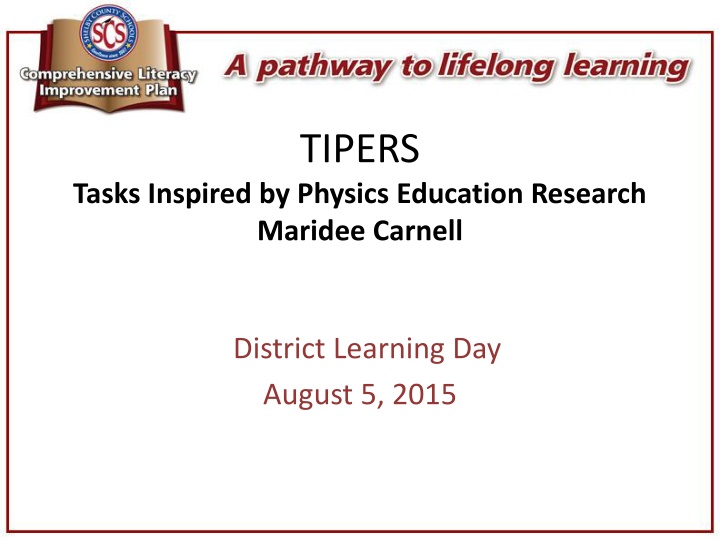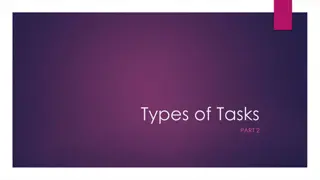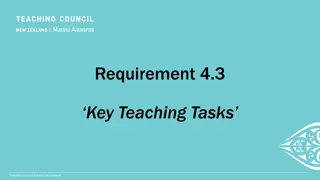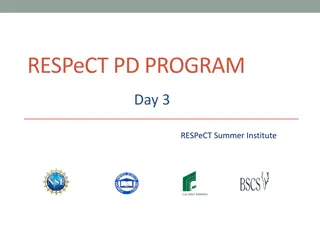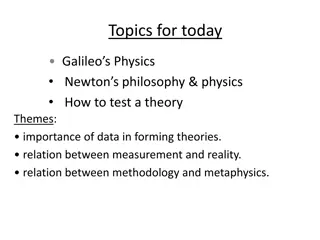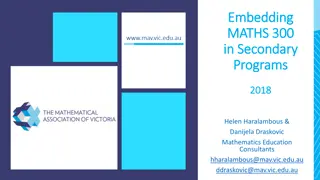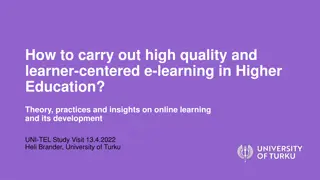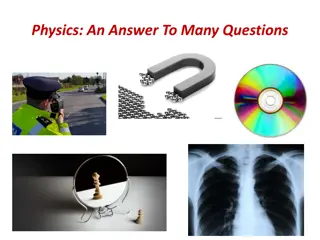Enhancing Physics Education Through TIPERS Tasks and Student-Centered Approaches
Explore the world of physics education research with TIPERS tasks, focusing on student-centered learning and promoting reasoning skills. Discover strategies to engage students in constructing models, developing functional understanding, and utilizing alternative assessments. Engage in various types of questioning tasks to inspire creativity and critical thinking among learners.
Uploaded on Sep 29, 2024 | 0 Views
Download Presentation

Please find below an Image/Link to download the presentation.
The content on the website is provided AS IS for your information and personal use only. It may not be sold, licensed, or shared on other websites without obtaining consent from the author.If you encounter any issues during the download, it is possible that the publisher has removed the file from their server.
You are allowed to download the files provided on this website for personal or commercial use, subject to the condition that they are used lawfully. All files are the property of their respective owners.
The content on the website is provided AS IS for your information and personal use only. It may not be sold, licensed, or shared on other websites without obtaining consent from the author.
E N D
Presentation Transcript
TIPERS Tasks Inspired by Physics Education Research Maridee Carnell District Learning Day August 5, 2015
Do Now Do now activity goes here
Norms Be present and engaged. Be respectful of differences in perspective while challenging each other productively and respectively. Monitor air time. Make the most of the time we have. Stay focused on students.
Objectives What will participants: Know How to provide students with what they need to go through the process of constructing models Understand How to design instruction to develop functional understanding Do Utilize alternatives to traditional assessments
TIPERS Students need to go through the process of constructing models and applying them to predict and explain real-world phenomena.
Tipers What is it that your students can and cannot do?
Students Tend to Learn with Minimal Instruction Designed to promote reasoning skills Establish a strong functional understanding Modification of misunderstanding/misconceptions Uses Part of instruction Diagnostic assessment Formative or Summative Assessment Stand-alone tasks interactive engagement approaches Can be used for individuals or in group discussion Bell work Ticket out the door
ask difficult questions about simple things Students will generate very informative, not to mention creative, explanations for why there are errors in the item Student answers then provide a number of new tasks My goal: inspire teachers to create their own tasks
Types of questions Ranking Tasks (RT) Working Backwards Tasks (WBT) What, if anything, is Wrong Tasks (WWT) Troubleshooting Tasks (TT) Bar Chart Tasks (BCT) Student Contentions Tasks (SCT) Linked Multiple Choice Tasks (LMCT) Changing Representations Tasks (CRT) Qualitative Reasoning Tasks (QRT) Comparison Tasks (CT)
1. Rank the magnitude (sizes) of slopes of the line at the labeled points. Explain you reasoning.
2. Rank the slopes of the lines in this graph. Explain you reasoning.
3. Rank the magnitude (sizes) of slopes of the graph at the labeled points. Explain you reasoning.
4. Rank the slopes of the graph at the labeled points. Explain you reasoning.
5. Is the slope of the graph (a) greater Case A (b) greater in Case B (c) the same in both cases?. Explain you reasoning.
6. Rank the slopes of the graph at the labeled points. Explain you reasoning.
A student uses data from the table to make a graph as shown. X Y 7. What, if anything, is wrong with this graph? If something is wrong, identify and explain how to correct all errors. If it is correct, explain why. 0. 2 0.1 0. 4 0.9 0. 6 1.9 0. 8 3.3 1. 0 5.7 1. 2 8.8 1. 4 14. 0
A website posts the following graph of the number of monthly visits during the past year. The web site owner makes the following statement about this graph. As you can see, this year our popularity has grown dramatically, and we look forward to continued success. 8. What, if anything, is wrong with this statement? If something is wrong, identify and explain how to correct all errors. If this statement is correct, explain why.
A student is told the equation 3y=x represents the statement: There are three times as many cars as pickup trucks in the parking lot. She says, The letter x represents the cars, and the letter y represents the pickups. 9. What, if anything, is wrong with the equation? If something is wrong, identify and explain how to correct all errors. If this is correct, explain why.
To express the relationship between inches and feet, someone writes 12I = 1F . Three students discussing this relation state: Amy: The letter I is used as a unit in this case. There aren t any variables in this equation. Bea: The letter I is a variable and represent the number of inches. Care: That can t be right, because if I let I equal 12 inches, then I get 144 inches equals 1F. And then there are only 12 inches in a foot. 10. With which, if any, of these students do you agree? Explain your reasoning.
A student is asked to represent the statement For every five girls on the dance floor, there are three boys using G to represent the number of girls and B to represent the number of boys. He writes 5G=3B. 11. What, if anything, is wrong? If something is wrong, identify and explain how to correct all errors. If this is correct, explain why.
A student is told that the equation 7y = 4x represents the statement For every seven hours of texting I get charged $4. She says The letter x represents the number of hours texting, and the letter y represents the number of dollars I am charged. 12. What, if anything, is wrong? If something is wrong, identify and explain how to correct all errors. If this is correct, explain why.
A student makes the following claim about some data that he and his lab partners have collected: Our data shows that the value of y decreases as x increases. We found that y is inversely proportional to x. 13. What, if anything, is wrong with this statement? If something is wrong, identify and explain how to correct all errors. If this statement is correct, explain why.
Six y vs x graphs are shown on a single set of axes. 14. Which, if any, of these graphs is consistent with the statement If x doubles, they y also doubles? Explain your reasoning.
Four students solving a math problem obtain the following equation: 4abx = cax + 2b They want to solve for x, and make the following statements about what to do next: Aubrie: There s nothing we can do until we plug in numbers for a, b, and c. Bayan: We need to get all the x terms on one side, so we should subtract cax from both sides. Cherise: I agree, but first we can simplify, There s an a on both sides, and we can cancel them. Didier: I agree that we need to get all the x terms on one side, but to do that we should divide by cax. 15. With which, if any, of these students do you agree? Aubrie ______ Bayan ______ Cherise ______ Didier ______ None of them ______ Explain your reasoning.
Three students solving a math problem obtain the following equation: 4abx = cax + 2b They are not sure the equation is reasonable, and make the following statements about the units: Alan: I don t think this can work because the different variables should have different units, which means the equation would be inconsistent. Bri: I disagree: I think it could work if a and x are something like m and 1/m. Chas: I agree with Bri, but only if c has the same units as b in addition to what Bri said. 16. With which, if any, of these students do you agree? Alan ______ Bri ______ Chas ______ None of them ______ Explain your reasoning.
A student is solving a problem using an equation that includes the variables x, y, and z. She says, We need to simplify the equation 1 for z. First we invert, which gives ? = ? + ?. Then we solve for z by subtracting y from both sides, and we get ? = ? ?. 1 ?+1 ?= ? and then solve 17. What, if anything, is wrong? If something is wrong, identify and explain how to correct all errors, If this is correct, explain why.
18. Which, if any, of these equations is consistent with the statement If x doubles, they y also doubles? Explain your reasoning. A. y = 2x B. y = 3x C. y= 2x + 7 D. y = -4x E. y = x2
Four students are mixing lemonade using a lemonade concentrate and water. They all have different recipes. In the diagrams, the darker cans represent lemonade concentrate and the lighter cans represent water. 19. Rank the mixtures based on how strongly flavored they are. Explain your reasoning.
Four basketball players have the following statistics for free- throws: Name Baskets Made Baskets Missed A Aliza 13 6 B Berta 14 3 C Claudia 7 3 D Diana 6 3 20. Based only on this small amount of data, rank the free- throw skills of the players. Explain your reasoning.
Four basketball players have the following statistics for free-throws: Name Baskets Made Baskets Missed A Amalie 43 12 B Beth 77 18 C Cami 61 19 D Diethra 58 11 21. Based only on their free-throw statistics, choose teams for a 2- on-2 basketball game that is evenly matched as possible. Explain your reasoning. 22. For the teams you have chosen (and again based only on their free-throw statistics), which team is likely to win? Explain your reasoning.
Picture B at the right was made by enlarging picture A on a photocopying machine. The distance between point x and point y measures 1.4 times as large in picture B as in picture A, and the distance between point x and point z also measures 1.4 times as large as picture B. Consider the following claims made by students about the two pictures: Andres: The distance form y to z is also 1.4 times as large in picture B as in picture A. Picture B is 1.4 times as large in any direction. Blas: The area of the triangle xyz will be 1.4 times as large in picture B as in picture A. Picture B is 1.4 times as large in any direction. Cervita: The angle yzx is also 1.4 times as large in picture B as in picture A. Daniel: The circumference of the circle in the upper- right-hand corner of the picture is 1.4 times as large in picture B as in picture A. Esther: The area of the circle in the upper right hand corner of the picture is 1.4 times as large in picture B as in picture A. Anything you can measure in picture B will be 1.4 times as large as what you measure in A. Freddie: The length of the dart is 1.4 times as large in picture B as in picture A. Genaro: The area of the dart is 1.4 times as large in picture B as in picture A. 23. Which, if any, of these students do you agree? Explain your reasoning. Andres_____Blas_____Cervita_____Daniel_____Esther_____Freddie_____Genaro_____None of them_____c
A woodworker has made four small airplanes and one large airplane. All airplanes are exactly the same shape, and all are made from the same kind of wood. The larger plane is twice as large in every dimension as one of the smaller planes. The planes are to be painted and then shipped as gifts. The amount of paint required to paint the planes is directly proportional to the surface area. 24. Will the amount of paint required for the single plane in Case A be (a) greater than, (b) less than or (c) equal to the total amount of paint required for all four planes in Case B? Explain your reasoning.
A woodworker has made four small airplanes and one large airplane. All airplanes are exactly the same shape, and all are made from the same kind of wood. The larger plane is twice as large in every dimension as one of the smaller planes. The planes are to be painted and then shipped as gifts. The Shipping cost for the planes is proportional to the weight which is related directly to the volume. 25. Will the weight of the single plane in Case A be (a) greater than, (b) less than or (c) equal to the total weight of all four planes in Case B? Explain your reasoning.
A student is told that 5 kg of pennies have a value of $20. The student has to find the value of the same mass of nickels, knowing that a nickel has twice the mass of a penny. The student carries out the following calculation: $20 is 2,000 pennies, and they have a mass of 5 kg. If I have the same mass of nickels that are each twice the mass of a penny, then I will have 1,000 nickels. That means that I would have $50. 26. What, if anything, is wrong with this student s analysis? If something is wrong, identify and explain how to correct it. If nothing is wrong, complete the explanation.
Three students are working on the following problem: If it takes 70 hours to dig a coal mine rescue shaft 300 feet deep, how long should it take to dig another coal mine rescue shaft 1,500 feet deep? The students make the following contentions: Ally: Since it took 70 hours to dig 300 feet it will take five times as long to dig five times as deep, so it will take 350 hours. Bill: It takes them a little less than a quarter of an hour to dig one foot, so I get 349.5 hours, which almost agrees with Ally, but I am not sure who has the right answer. Clyde: The workers were able to dig at a rate of 4.29 feet per hour for the first shaft, so if they can dig the same for the second it will take 349.7 hours. So I think we all agree and the numbers only differ because of rounding errors. 27. Which, if any, of these students do you agree? Explain your reasoning. Ally_____Bill_____Clyde_____None of them_____
28. Since 2,000 pennies have a mass of n kg, how many pennies would be needed to produce a mass of 1.6n kg? Explain.
A certain physics test, which is several pages long, is copied on 20- pound paper (500 sheets have a weight of 20 pounds) so the weight per test is 0.25 pounds. The class has 39 students, so the instructor makes 40 copies of the test. What is the weight of the paper that he brings to class on test day? A student presented with this problem carries out the following analysis: To find the total weight of the paper in the tests I need to divide the 40 copies by the 0.25 test/pounds, and that will give me 16 pounds. 29. The student analysis is wrong; identify the problem and explain how to correct it.
Reflection: MODELING What resonated with you? What is similar to your current practice? What is different than your current practice? What are you going to change as a result?
Reflection: Application What was easiest for you? What was most difficult? What else do you need to learn/do prior to applying to your classroom?
Revisit Objectives What will participants: Know How to identify what students can and cannot do Understand How to design instruction to develop functional understanding Do Assess effect on student learning
Next steps and activities for follow up Participants will become a part of the Physics Collaborative to create their own tasks.
Reflection: One minute paper on post-it Jot down your Take-Aways Consider what you need to know and be able to do to successfully implement what you have learned in this session. What is still unclear? What professional development or additional resources do you need?
District Contacts Rita Moore, Science Advisor moorerf@scsk12.org 901-416-7989
